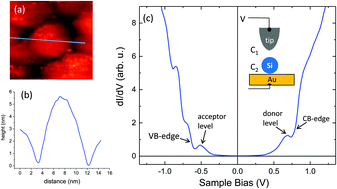Our official English website, www.x-mol.net, welcomes your
feedback! (Note: you will need to create a separate account there.)
Size-dependent donor and acceptor states in codoped Si nanocrystals studied by scanning tunneling spectroscopy
Nanoscale ( IF 5.8 ) Pub Date : 2017-11-06 00:00:00 , DOI: 10.1039/c7nr06257e Or Ashkenazi 1, 2, 3, 4 , Doron Azulay 1, 2, 3, 4, 5 , Isaac Balberg 1, 2, 3, 4 , Shinya Kano 6, 7, 8, 9, 10 , Hiroshi Sugimoto 6, 7, 8, 9, 10 , Minoru Fujii 6, 7, 8, 9, 10 , Oded Millo 1, 2, 3, 4
Nanoscale ( IF 5.8 ) Pub Date : 2017-11-06 00:00:00 , DOI: 10.1039/c7nr06257e Or Ashkenazi 1, 2, 3, 4 , Doron Azulay 1, 2, 3, 4, 5 , Isaac Balberg 1, 2, 3, 4 , Shinya Kano 6, 7, 8, 9, 10 , Hiroshi Sugimoto 6, 7, 8, 9, 10 , Minoru Fujii 6, 7, 8, 9, 10 , Oded Millo 1, 2, 3, 4
Affiliation

|
The electrical and optical properties of semiconductor nanocrystals (NCs) can be controlled, in addition to size and shape, by doping. However, such a process is not trivial in NCs due to the high formation energy of dopants there. Nevertheless, it has been shown theoretically that in the case of B and P (acceptor/donor) codoped Si-NCs the formation energy is reduced relative to that of single type doping. Previous comprehensive measurements on ensembles of such codoped Si-NCs have pointed to the presence of donor and acceptor states within the energy gap. However, such a conjecture has not been directly verified previously. Following that, we investigate here the electronic properties of B and P codoped Si-NCs via Scanning Tunneling Spectroscopy. We monitored the quantum confinement effect in this system, for which the energy gap changed from ∼1.4 eV to ∼1.8 eV with the decrease of NC diameter from 8.5 to 3.5 nm. Importantly, all spectra showed two in-gap band-states, one close to the conduction band edge and the other to the valence band edge, which we attribute to the P and B dopant levels, respectively. The energy separation between these dopants states decrease monotonically with increasing NC diameter, in parallel to the decrease of the conduction-to-valence bands separation. A fundamental quantity that is derived directly for these Si-NCs is the intrinsic like position of the Fermi energy, a non-trivial result that is very relevant for understanding the system. Following the above results we suggest an explanation for the character and the origin of the dopants bands.
中文翻译:

通过扫描隧道光谱研究共掺杂硅纳米晶体中尺寸依赖的供体和受体态
除了尺寸和形状以外,还可以通过掺杂来控制半导体纳米晶体(NCs)的电学和光学特性。然而,由于其中掺杂剂的高形成能,在NC中这样的过程并不简单。尽管如此,理论上已经表明,在B和P(受体/施主)共掺杂的Si-NC的情况下,形成能量相对于单一类型的掺杂降低。先前对此类共掺杂Si-NC的集合体进行的全面测量已指出,在能隙内存在供体和受体态。但是,这样的猜想以前还没有直接得到验证。随后,我们在这里探讨B和P的电子特性共掺硅纳米晶通过扫描隧道光谱。我们监测了该系统中的量子限制效应,该过程的能隙从〜1.4 eV变为〜1.8 eV,并且NC直径从8.5 nm减小至3.5 nm。重要的是,所有光谱均显示出两个能隙内能带状态,一个接近导带边缘,另一个接近价带边缘,我们分别将其归因于P和B掺杂水平。这些掺杂态之间的能量分离随NC直径的增加而单调减小,与导带和价带间距的减小平行。直接为这些Si-NC推导的基本量是费米能量的内在相似位置,这是一个非平凡的结果,对于理解系统非常重要。
更新日期:2017-11-23
中文翻译:

通过扫描隧道光谱研究共掺杂硅纳米晶体中尺寸依赖的供体和受体态
除了尺寸和形状以外,还可以通过掺杂来控制半导体纳米晶体(NCs)的电学和光学特性。然而,由于其中掺杂剂的高形成能,在NC中这样的过程并不简单。尽管如此,理论上已经表明,在B和P(受体/施主)共掺杂的Si-NC的情况下,形成能量相对于单一类型的掺杂降低。先前对此类共掺杂Si-NC的集合体进行的全面测量已指出,在能隙内存在供体和受体态。但是,这样的猜想以前还没有直接得到验证。随后,我们在这里探讨B和P的电子特性共掺硅纳米晶通过扫描隧道光谱。我们监测了该系统中的量子限制效应,该过程的能隙从〜1.4 eV变为〜1.8 eV,并且NC直径从8.5 nm减小至3.5 nm。重要的是,所有光谱均显示出两个能隙内能带状态,一个接近导带边缘,另一个接近价带边缘,我们分别将其归因于P和B掺杂水平。这些掺杂态之间的能量分离随NC直径的增加而单调减小,与导带和价带间距的减小平行。直接为这些Si-NC推导的基本量是费米能量的内在相似位置,这是一个非平凡的结果,对于理解系统非常重要。











































 京公网安备 11010802027423号
京公网安备 11010802027423号